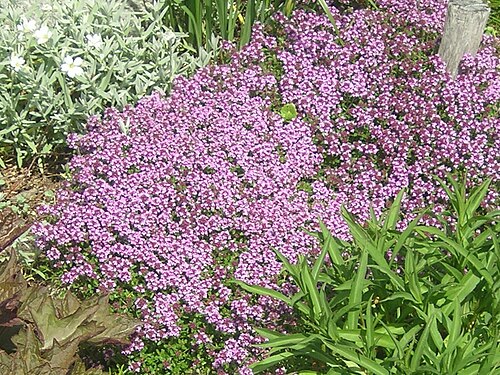Thymus serpyllum
| Habit | herbaceous
| |
|---|---|---|
| Height: | ⇕ | 1 in"in" can not be assigned to a declared number type with value 1. to 4 in"in" can not be assigned to a declared number type with value 4. |
| Width: | ⇔ | 36 in"in" can not be assigned to a declared number type with value 36. |
| Lifespan: | ⌛ | perennial |
| Bloom: | ❀ | early summer, mid summer, late summer |
| Exposure: | ☼ | sun |
|---|---|---|
| Features: | ✓ | fire resistant |
| USDA Zones: | 4 to 9 | |
| Flower features: | ❀ | blue, purple |
|
Thymus > |
- "Creeping Thyme" and "Wild Thyme" redirect here. In some places, these names refer to Thymus praecox.
Thymus serpyllum, known by the common names of Wild Thyme or Creeping Thyme is a species of thyme native to most of Europe and North Africa. It is a low, usually prostrate subshrub growing to 2 cm tall with creeping stems up to 10 cm long, with oval evergreen leaves 3-8 mm long. The strongly scented flowers are either lilac, pink-purple, magenta, or a rare white, all 4-6 mm long and produced in clusters. The hardy plant tolerates some pedestrian traffic and produces odors ranging from heavily herbal to lightly lemon, depending on the plant.
Read about Thymus serpyllum in the Standard Cyclopedia of Horticulture
|
|---|
|
Thymus serpyllum, Linn.; also spelled Serpyllus (T. azoricus, Lodd. T. hirsutus, Auth. not Bieb. T. micans, Lowe). Mother of Thyme. Creeping Thyme. Perennial or subshrubby, cespitose or creeping: sts. wiry, prostrate and rooting below, ascending-erect above, slightly puberulent: lvs. elliptic, oblong or ovate, obtuse base more or less attenuate, seldom 1/2 in. long, short-petioled: floral-whorls sessile, congested into a head or the lower more or less distant and racemose: fls. minute, lilac or rose; calyx more or less hairy, 2-lipped to the middle, teeth of upper lip triangular, glabrous or ciliate, of lower lip 2, lanceolate-subulate, ciliate; corolla-tube rather included. Temperate parts of Eu., Asia, and N. Afr.—A common plant in old gardens, prized as an evergreen edging and as cover for rockwork and waste places; also run wild. The lvs. are sometimes used for seasoning, as are those of T. vulgaris. The nodes are short, making it a very leafy plant. Variable. Var. albus, Hort., is a white-fld. form. Var. argenteus. Hort., is a form with silver variegated lvs. commonly known in the trade as T. citriodorus argenteus, Hort. Var. aureus, Hort., is a form with golden variegated lvs. growing about 8-12 in. high; usually known in the trade as T. aureus, Hort., or T. citriodorus aureus, Hort.; there is also a minor variation known in the trade as T. Serpyllum aureus marginatus. Var. Chaubardii, Boiss. & Heldr., see T. heterotrichus. Var. citriodorus, Hort., see var. vulgaris. Var. coccineus, Hort. (T. coccineus, Hort.). grows about 1 1/2- 3 in. high, has dark green lvs. and bright crimson fls. Var. lanuginosus, Hort. (T. lanuginosus, Mill. T. Chamaedrys lanuginosus, Hort.). is a low form, about 3 in. high with small roundish lvs. which are gray-pubescent; a good edging plant. Var. montanus, Benth. (T. montanus, Waldst. & Kit. T. Chamaedrys, Auth., not Fries), is a form with the branchlets more erect and the lvs. larger than the type. Var. pulchellus, Hort., has the upper part of the calyx and its teeth purple. Var. splendens, Hort., is a form with brilliant red (according to some bright purplish red) fls. Var. variegatus, Hort., has white-variegated lvs., possibly the same as var. argenteus. Var. vulgaris, Benth. (T. Serpyllum var. citriodorus, Hort. T. citriodorus, Schreb.). Lemon Thyme. Lvs. smaller than the type and strongly veined; the plant has a decided lemon odor. CH
|
Cultivation
- Do you have cultivation info on this plant? Edit this section!
Propagation
- Do you have propagation info on this plant? Edit this section!
Pests and diseases
- Do you have pest and disease info on this plant? Edit this section!
Species
Gallery
If you have a photo of this plant, please upload it! Plus, there may be other photos available for you to add.
References
- Standard Cyclopedia of Horticulture, by L. H. Bailey, MacMillan Co., 1963
External links
- w:Thymus serpyllum. Some of the material on this page may be from Wikipedia, under the Creative Commons license.
- Thymus serpyllum QR Code (Size 50, 100, 200, 500)






